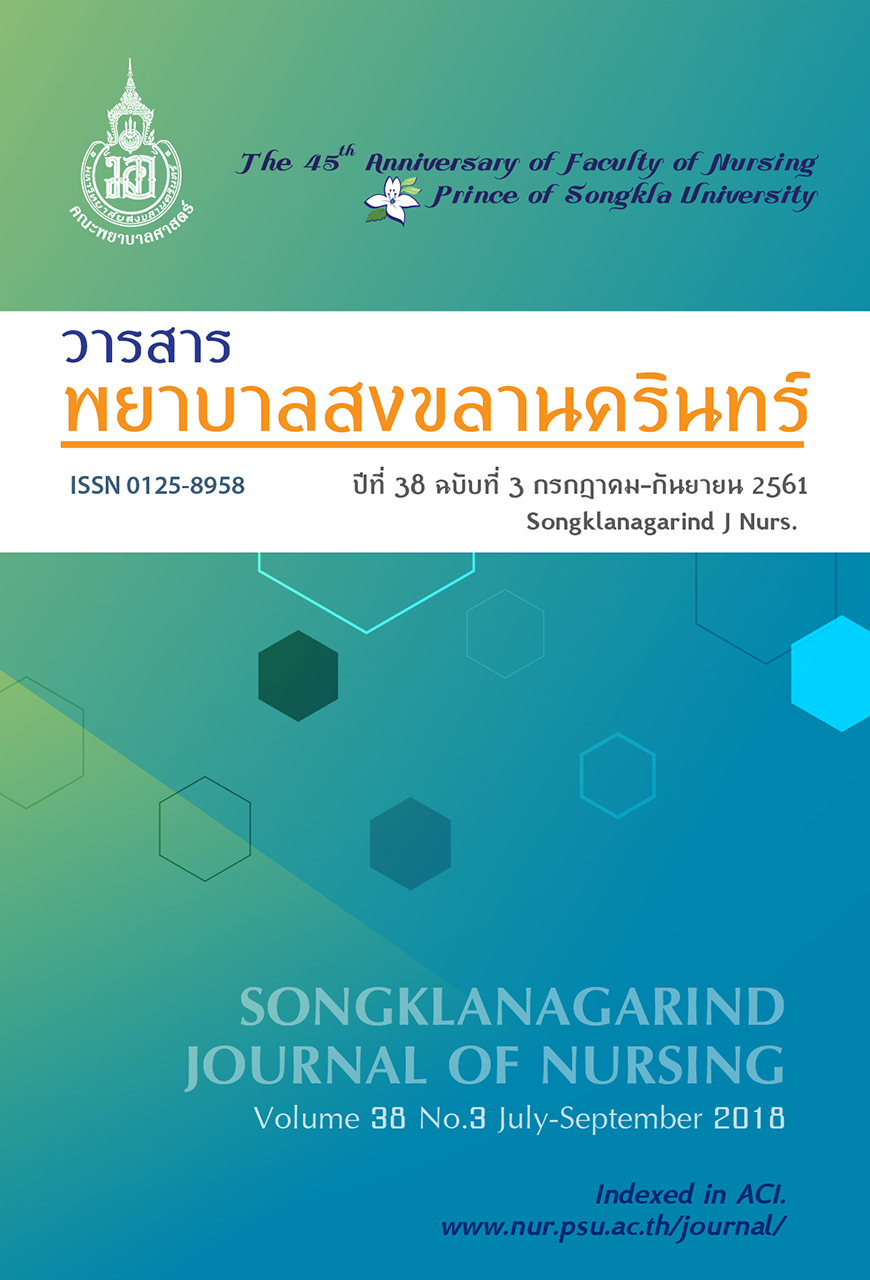การรับรู้เรื่องการมีเพศสัมพันธ์ที่ปลอดภัยและแนวทางการป้องกัน การติดเชื้อเอชไอวีในวัยรุ่นชาย:การวิจัยเชิงคุณภาพ
Main Article Content
บทคัดย่อ
งานวิจัยเชิงคุณภาพนี้ มีวัตถุประสงค์เพื่อศึกษาการรับรู้เรื่องเพศสัมพันธ์ที่ปลอดภัยและแนวทางการป้องกันเอชไอวี
ในกลุ่มวัยรุ่นชาย ทำการศึกษาระหว่างเดือนธันวาคม 2559-มีนาคม 2561 ผู้ให้ข้อมูลเป็นวัยรุ่นชาย อายุระหว่าง 20-26 ปี
จำนวน 19 ราย ที่สมัครใจเข้าร่วมการวิจัย การวิจัยนี้ได้ผ่านการพิจารณาโดยคณะกรรมการวิจัยในมนุษย์ มหาวิทยาลัยราชภัฏ
สุราษฎร์ธานี ทำการรวบรวมข้อมูลโดยการสัมภาษณ์เชิงลึกรายบุคคล และการสัมภาษณ์แบบกลุ่มผู้ให้ข้อมูลได้รับการสัมภาษณ์
เชิงลึกและบันทึกเสียง เป็นระยะเวลา 45-60 นาที จำนวน 1 ครั้ง ข้อมูลการวิจัยที่ได้จากการถอดเทปจะถูกนำมาตรวจสอบ
ความถูกต้องโดยทีมผู้วิจัย และสุ่มตรวจทานโดยผู้ให้ข้อมูล และทำการวิเคราะห์ข้อมูลเชิงคุณภาพ โดยการวิเคราะห์เชิงเนื้อหา
โดยใช้โปรแกรมสำเร็จรูป NVivo 11 ในการจัดการข้อมูล
ผลการวิจัย พบว่า ผู้ให้ข้อมูลสะท้อนอุปสรรคในการรับรู้เรื่องเพศสัมพันธ์ที่ปลอดภัย ได้แก่ ด้านแรงสนับสนุนทางสังคม
ด้านปัจเจกบุคคล เช่น การไม่ขวนขวายเรียนรู้จากสื่อ ด้านการเข้าถึงข้อมูลเกี่ยวกับการป้องกันเอชไอวี นอกจากนี้ แนวทาง
การป้องกันการติดเชื้อเอชไอวี พบว่า ผู้ให้ข้อมูลสะท้อนถึงกลวิธีที่เพิ่มประสิทธิภาพในการป้องกันการติดเชื้อในกลุ่มวัยรุ่นชาย
ได้แก่ การเพิ่มการสนับสนุนจากสถาบันการศึกษา การใช้กลวิธีที่เฉพาะเจาะจงในกลุ่มวัยรุ่นชาย และการสร้างความตระหนัก
ในการป้องกันพฤติกรรมเสี่ยงทางเพศ
จากผลการวิจัยครั้งนี้ หน่วยงานทางสุขภาพควรผลักดันสถานศึกษาให้เข้ามามีส่วนร่วมในการดำเนินกิจกรรมการ
รณรงค์ป้องกันเอชไอวี รวมถึงการผลักดันอาจารย์ที่ปรึกษาที่มีศักยภาพและความพร้อมในการให้การปรึกษาได้ตรงกับบริบท
ของวัยรุ่นชาย
Article Details
เอกสารอ้างอิง
2. WHO. HIV/AIDS: Global situation and trends [Internet]. [cited 2018 April 10]. Available from:http://www.who.int/gho/hiv/en/
3. Bureau of Epidemiology. AIDS situation in Thailand [Internet]. [cited 2018 June 30]. Available from: http://www.boe.moph.go.th/files/report/20151126_87903337.pdf
4. Bureau of Epidemiology Thailand. Thailand HIV/AIDS annual report 2014 [Internet]. [cited 2018 June 26]. Availablefrom: http://www.boe.moph.go.th/files/report/20141128_61345755.pdf
5. Bureau of Epidemiology Thailand. Overview of HIV epidemiology in Thailand, 2013 [Internet].[cited 2018 July 1]. Available from: http://www. boe.moph.go.th/files/report/20141128_31017647.pdf
6. Bureau of Epidemiology Thailand. Annual Epidemiological Surveillance Report [Internet]. [cited 2018 July 9]. Available from: http://www.boe.moph.go.th/Annual/AESR2014/aesr2557/Part%201/1-6/1-6-1.pdf
7. Prachanno W, Srisuriyawet R, Homsin P. Factors influencing sexual behaviors among primary school students based on the information–motivation–behavioral skills model. Journal of Nursing Science Chulalongkorn University. 2017;29(2). Thai.
8. Yiwu Z. Cultural challenges of globalization. Journal of Contemporary China 2008;17(57):733-46. doi: 10.1080/10670560802253485
9. Sripol R. Factors related to sexual behaviour among youth in Loei province. Journal of the office of DPC 7 Khon Kan 2016;23(2):101-11.Thai.
10. Wanich P. Guidelines on adapting youth’s prematurely sexual behaviour for sustainable solution in Huai Chorakhemak, Buriram Province. Journal of Research and Development Buriram Rajabhat University 2015; 10(1):78-88. Thai.
11. Buachamrut S. AIDS preventive behaviors of students in industrial and community education College, Chaiyaphum province. Research and Development Health System Journal 2011;1(4).Thai.
12. Sawangtook S, Thano P. The study of the awareness of sexual risk behaviors and sexual risk behaviors of adolescent students. Kuakarun Journal of Nursing 2015; 22(2) 41-56.Thai.
13. Pornchaikate A, Yeong A, Chamratrithirong A, Yuttatri P. Sexual communication between adolescents and their close friends: differences between boys and girls. Journal of Nursing Science 2015;33(2)19.28. Thai.
14. Creswell JW. Qualitative inquiry and research esign: Choosing among five approaches. Thousand Oaks, California, USA: SAGE Publications; 2013.
15. Singhor S, Chamroonsawasdi K, Charupoonphol P, Kittipichai W. Intention to practice positive behaviours of transmission and acquisition among teenagers with HIV in risk areas of Thailand. Journal of Public Health and Development. 2014;12(2).Thai.
16. Yangyuen S, Mahaweerawat U, Somdee T, Songkang S. Concerning safe sex among adolescent. J Sci Technol MSU 2010; 29(4):420-7. Thai.
17. Balthip Q, Chandrema S. Process of establishing purpose of life of Thai teenagers living with HIV. Songklanagarind J Nurs 2013; 33(3):1-16.Thai.
18. Thuainan P, Viroj J, Chewnarupai W. Factors associated with using condom when having sex: Students of Mathayomsuksa five at Mahasarakham province in 2013. Journal of Science and Technology 2015;34(2):180-6.Thai.
19. Pojanapotha P, Singhakant S, Kaewpornsawan T, Apinuntavech S. Attitudes and sex education associated with sexual behavior in Thai male students in Bangkok. Journal of public Health 2017; 47(1):18-30. Thai.
20. Heednakram U, Kasatpibal N, Visesku N. Effect of parent communication skill development on communication about HIV prevention between parents and early adolescents. Nursing Journal 2015; 42(Suppl). Thai.


